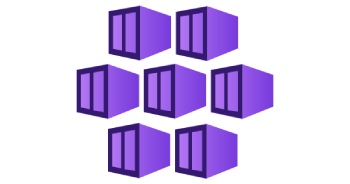What is Azure Kubernetes Service (AKS)?

Azure Kubernetes Service (AKS) is Microsoft’s fully managed Kubernetes service in Azure. The open-source, fully managed containerisation service simplifies deploying, managing, and operating clusters without requiring you to handle the underlying infrastructure directly.
AKS's main goal, as a managed service, is to simplify the deployment and management of applications using Kubernetes.
What is Amazon Kubernetes Service (AKS)?

Elastic Kubernetes Service (EKS) is a fully managed Kubernetes service by Amazon that simplifies the deployment and management of containerised applications at scale.
Built on AWS infrastructure, Amazon EKS offers features like automatic capacity planning and resilience for workloads.
AKS vs EKS: A Side-by-Side Comparison

Both cloud providers replicate the same Kubernetes components, where core components like services, deployments, and the API behave the same across platforms. The key differences come down to the surrounding features.
Each adds its own specific capabilities that can support different use cases. These differences might seem minor, but they can have a significant impact depending on what you’re building. Let’s break down how AKS and EKS compare:
| Feature |
AKS |
EKS |
| Control Plane Management |
Automatic by Azure |
Automatic by AWS |
| Authentication and Authorisation |
Microsoft Entra ID |
AWS IAM |
| Auto Scaling |
Nodes and Pods |
Nodes and Pods, AWS Fargate |
| Monitoring and Logging |
Azure Monitor, Log Analytics, Managed Prometheus, Managed Grafana |
Amazon CloudWatch, CloudTrail |
| Ecosystem Integration |
Azure DevOps, GitHub, Terraform, Helm, Azure SQL Databases and Azure Blob Storage |
AWS Services (RDS, S3, Lambda) |
| Security and Compliance |
Azure Policy, VNet |
AWS Policies, VPC |
| Management Interface |
Azure Portal, Azure CLI, kubectl |
AWS Console, AWS CLI, eksctl, kubectl |
| Costs |
Control plane for free (for small clusters and dev/test environments), Standard includes costs
Cloud resources billed don a pay-per-use basis |
Costs for the control plane, and costs for using resources in EKS |
Ease of setup
- AKS: AKS is the easiest to set up. It’s a basic point-and-click experience; a couple of clicks, and you have a running cluster. Cluster management is convenient, especially for those already using Azure services.
- EKS: Is more complex and takes a few more steps to get going. Deploying clusters requires configuring the AWS console and connecting worker nodes via kubectl.
Control Plane
- AKS: When you deploy an AKS cluster, Azure provisions a dedicated control plane (API server, scheduler, etcd) for your cluster. While you don’t manage this infrastructure directly, it runs isolated from other tenants and is fully managed by Microsoft. This enforces isolation and is great for control and separation. In addition, AKS integrates well with Microsoft Entra ID to manage authentication and role-based access control.
- EKS: EKS also provides a single-tenant control plane for each cluster. For access control, EKS relies on IAM roles to manage authentication and authorisation. Permission management is very granular, especially when using Fargate. You can assign IAM roles to specific containers, groups, or VPCs.
Autoscaling
- AKS: AKS supports both cluster autoscaler (for scaling nodes) and the Horizontal Pod Autoscaler, HPA (for scaling workloads). With native Karpenter support, AKS can now provision and terminate nodes dynamically, based on real-time scheduling needs. This way, the need to pre-define node pools or manage VM SKUs manually is reduced. AKS also supports Kubernetes Event Driven Auto Scaler (KEDA) for event-driven scaling and scaling to zero. It also offers Node Auto Provisioning (preview) to dynamically create and remove VMs based on workload requirements. And Azure supports serverless and event-driven architectures with Azure Functions. Read more about the technologies for scaling on AKS.
- EKS: Supports multiple forms of autoscaling, including Cluster Autoscaler for EC2-based workloads, which adjusts the number of nodes based on pending pods. Also, Karpenter is a flexible autoscaling option in AKS which provisions the right EC2 instances in real-time without needing predefined node groups. Pod-level scaling is also possible as EKS supports Horizontal Pod Autoscaler (HPA), using CPU, memory, or custom metrics. Vertical Pod Autoscaler is also available but used mainly for resource recommendations. Also, Fargate lets you run containers without managing servers.
Integration
- AKS: AKS integrates deeply with Azure services and popular DevOps tools. You can:
- Use GitHub Actions or Azure DevOps pipelines to deploy to AKS
- Deploy apps with Helm, including private Helm repos
- Connect to services like Azure SQL, Blob Storage, and Azure Key Vault
- Integrate with Azure Monitor, Defender for Containers, and Azure Policy for observability and compliance
- EKS: Integrates well with most AWS-native services like:
- Elastic Load Balancing, RDS, DynamoDB, S3, CloudWatch, and IAM
- CloudFormation and Terraform for IaC
- App Mesh for service mesh use cases
- EKS also works well with open-source tools like Helm, Argo CD, and GitHub Actions.
Networking
- AKS: AKS networking is private by default when using Azure CNI, which assigns IPs from your virtual network to pods and nodes. This gives strong isolation and better control for enterprise setups. It handles subnet and availability zone configuration for you by default, so you can get started quickly. Advanced options like custom VNETs and route tables are available when needed, but not required upfront.
- EKS: EKS requires more manual setup for networking. You define VPCs, subnets, and AZ distribution yourself. This gives flexibility for custom architectures, but also adds complexity and setup time.
Kubernetes Version support and upgrades
- AKS: AKS supports new Kubernetes versions quickly — often shortly after upstream release. Microsoft now offers automated upgrades, scheduled maintenance windows, and pre-flight checks to validate cluster health before upgrading.
- EKS: While EKS used to lag behind AKS in Kubernetes version support, it has caught up in recent releases — sometimes even shipping versions earlier. EKS also supports automated control plane and node upgrades, with longer support windows (up to 14 months per version) giving teams more flexibility.
Node repairs
- AKS: Node repairs are per node. It monitors each node’s health and auto repairs when needed.
- EKS: EKS does not automatically repair nodes based on Kubernetes health signals. Managed Node Groups can replace failed EC2 instances at the infrastructure level, but not when nodes are stuck or degraded from Kubernetes’ perspective. For Kubernetes-aware node repairs, you’ll need to use a tool like Karpenter or implement custom logic.
Monitoring and Observability
- AKS: Strong monitoring, with tools like Azure Monitor and its integration with generative AI capabilities. Observability in Azure is very competitive. It supports integration with Datadog, New Relic, Splunk, Prometheus, Grafana, and more. This makes AKS a solid choice for teams already embedded in the Azure ecosystem, who want deep integrations and simplified management.
- EKS: Monitoring with CloudWatch and auditing with CloudTrail are solid; you can also plug in other tools. AWS, in general, has a long-standing reputation for observability.
Service Level Agreements (SLAs)
Service Level Agreements (SLAs) define expected availability as a percentage. This percentage represents the guaranteed uptime for your application over a set time period.
- AKS: In AKS, the free version has no SLA. Azure’s SLAs are only included if you use the Standard tier (billed at $0.10 per hour per cluster).
- 99.95% SLA for clusters deployed across Availability Zones
- 99.9% SLA for clusters not using Availability Zones
- EKS: SLAs that guarantees a Monthly Uptime Percentage of at least 99.95% for the Kubernetes endpoint during any monthly billing cycle.
Pricing
- AKS: You pay for the infrastructure resources your cluster uses, like VMSS (worker nodes), storage, and networking. Additionally, you can reduce costs by using Azure Spot VMs or Reservations.
The control plane is:
- Free in the Free tier (no SLA)
- $0.10/hour in the Standard tier (with SLA)
- $0.60/hour in the Premium tier (with SLA + Long-Term Support)
- EKS: EKS also costs $0.10 for the control plane (around $70 per month). You’ll also pay for EC2 instances, storage (EBS or EFS), load balancers (ALB), and any other resources your node groups use. Similar to as in AKS, the total cost depends on how efficiently you pack your workloads onto those nodes. It also supports cost-saving options like AWS Savings Plans, reserved instances, and spot instances for worker nodes.
Quota Limits
Every Kubernetes service enforces maximums on how much infrastructure you can run. These quota limits define how many clusters, nodes, pods, and node pools you’re allowed to use. Quota limits can be a real constraint for developers, especially in large or fast-scaling environments. Both AKS and EKS document these limits clearly:
- AKS:
- Clusters per region: 100 (CSP/PAYG); 1,000 (Enterprise Agreement)
- Node pools per cluster: 100
- Nodes per node pool: 1,000
- Nodes per cluster: 5,000 (with quota increase request, default setup supports up to 5,000)
- Pods per node: up to 250 (defaults vary by networking: 30 (kubenet) or 110 (Azure CNI); can be raised)
- EKS:
- Maximum of 100 clusters in each region
- Maximum of 100 nodes in node pools
- 3,000 nodes for each cluster
- Maximum of 737 pods per node
When it comes to quota limits, AKS supports more nodes per cluster (up to 5,000), while EKS allows higher pod density per node (up to 737 pods) depending on the instance type and network configuration.
- Choose AKS if your workload scales best by adding more nodes or node pools.
- Choose EKS if you need to run many pods per node or want flexibility tied to EC2 instance limits.
Each has strengths depending on how you scale, horizontally (nodes) vs. densely (pods).
Security
- AKS: It’s possible to enforce Pod Security Admission (PSA) based on Kubernetes Pod Security Standards (baseline, restricted, privileged) at the namespace level. However, this is not enabled by default; you need to configure it yourself. You can extend cluster security using Azure Policy and Gatekeeper for centralised control, audit, and compliance enforcement across clusters.
- EKS: Security-wise, AWS encourages strict separation by VPC – for example, one VPC per environment (production, UAT, QA, development). It implements pod security standards via the built-in PodSecurity admission controller, enforcing baseline and restricted profiles at the namespace level. AWS also offers Security Groups for network isolation.
Pros and Cons of AKS & EKS
Pros and Cons of AKS
| Pros |
Cons |
| ✅Fast support for Kubernetes versions |
❌Premium tier required for 2‑year LTS (added cost) |
| ✅Native Microsoft Entra ID integration (RBAC) |
❌Pod density per node lower than EKS by default |
| ✅Integrates deeply with Azure services (Monitor, DevOps, Key Vault, etc.) |
❌Free version is without SLA |
| ✅Centralised governance with Azure Policy + Gatekeeper |
❌Quota limits (nodes, pods) may require planning |
| ✅Free tier option for dev/test clusters |
|
| ✅Built‑in node auto‑repair |
|
Pros and Cons of AKS
| Pros |
Cons |
| ✅High pod density (up to 737 pods per node) |
❌Networking setup requires full VPC/Subnet configuration
|
| ✅Fine‑grained IAM at pod-level |
❌No Free control plane offering |
| ✅Strong HA across Availability Zones by default |
❌No official LTS;supported up to about 14 months |
| ✅Deep integration with AWS services (CloudWatch, RDS, S3, etc.) |
❌Kubernetes-aware node repair needs Karpenter or custom tooling |
| ✅Supports GitHub Actions, Terraform, eksctl |
❌Steeper learning curve for those new to AWS |
Use cases of AKS
Data analytics
In native applications, especially those involving data analytics, tools like MLflow integrate easily with AKS. The documentation and templates (blueprints) Microsoft provides also help reduce workload complexity.
Finance and banking
In finance and banking, AKS supports compliance needs well (e.g. GDPR, PCI-DSS). Microsoft’s tools for managing security and integrating with enterprise platforms make AKS suitable for complex regulatory environments.
E-commerce and Online gaming
AKS is a strong fit for both e‑commerce and online gaming infrastructure. Its high availability, multi-zone scalability, and low-latency networking make it ideal for applications where performance and reliability are key. Integration across Azure services also simplifies cross-cloud setups, even when combining AKS with EKS workloads.
Migration of existing applications
For large enterprise portals, especially those dealing with sensitive transactions or legacy systems, AKS simplifies migration and modernization. Microsoft offers tools to migrate from legacy systems (like AS/400) into AKS-based service.
Event-driven architectures
Azure managed add-ons like KEDA support event-driven architectures well, which is useful in large-scale enterprise applications.
Hybrid deployments
Azure excels in hybrid cloud deployments, as does AKS. AKS can communicate well with on-prem infrastructure using ExpressRoute, VPN gateways, or private peering. This allows you to connect AKS clusters to existing systems like databases, identity services, or backend apps without exposing them to the public internet.
It's a strong option for hybrid environments where part of the workload stays on-prem, especially in regulated industries or phased cloud migrations.
AI and Machine Learning
For AI and machine learning, Azure works great also. Deploying OpenAI models or running data analytics with Microsoft Fabric is pretty straightforward – thanks to Microsoft’s ecosystem. Tools like CoPilot and integration with Azure OpenAI service make it even better.
In AKS specifically, the KAITO add-on makes it easier to run GPU-powered AI workloads on Kubernetes. It automates GPU driver installation, supports NVIDIA GPU monitoring, and simplifies running ML pipelines in AKS.
Development and QA environments
Another strong use case is Dev and QA environments. With full integration into Visual Studio and Azure DevOps, you can spin up environments quickly, making AKS great for development pipelines.
Use cases of EKS
Multi‑zone & permissions management
EKS is well-suited for projects that require straightforward zone management and flexible IAM-based access control. Permissions can be managed at a granular level using IAM roles for specific containers, services, or VPCs.
Serverless applications
AWS Fargate offers a simpler alternative to node management. You don’t need to manage compute nodes manually, which simplifies operations – especially useful for teams focused on speed and automation.
Big data and observability
Tight integration with AWS tools like CloudWatch, CloudTrail, and third-party platforms (Datadog, New Relic) makes EKS ready for telemetry-rich and analytics-heavy workloads.
Financial services
For financial services, EKS has matured significantly and supports full security and compliance framework: GDPR, PCI-DSS, etc.
E-commerce
Amazon Elastic Kubernetes Service (EKS) is great for running e-commerce platforms. It supports high availability by distributing workloads across multiple availability zones. You can scale automatically based on traffic using managed node groups or Fargate.
Online gaming
Its low-latency networking makes it the preferred choice for online gaming infrastructure as well.
Secure, compliant environments
EKS delivers enterprise-ready security infrastructure and supports compliance standards (such as GDPR and PCI‑DSS).





